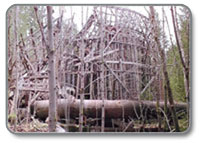Abandoned Mine Land Program

The Bureau of Land Management�s Abandoned Mine Lands (AML) program enhances public safety and improves water quality by reducing or eliminating the deleterious effects of past hardrock mining in the western United States. The BLM maintains an inventory of known abandoned mine lands on public lands. Most of the sites are abandoned hardrock mines.
As of April 2011, the BLM inventory nationwide contained 12,204 sites and 49,376 features. Approximately 20% of the sites have either been remediated, have reclamation actions planned or underway, or do not require further action. The remaining 80% require further investigation and/or remediation.
Oregon/Washington Abandoned Mine Land Program
The Abandoned Mine Lands program supports the Department of the Interior's Healthy Landscapes and Community Growth initiatives by remediating health, safety, and environmental hazards at abandoned mine sites on BLM lands. The AML program contributes to this effort to enhance water quality, visitor safety, recreation, and wildlife habitat by conducting studies and implementing remedial actions where necessary. Sites that have been remediated are monitored and maintained to ensure BLM actions were effective in protecting humans, wildlife, and the environment.
The main historical mining areas in Oregon are located in the southwest part of the state around Medford, Grants Pass, and Roseburg; and in the northeast part of the state around Baker City. In the State of Washington, the main areas of historical mining activity are located in the northern and northeastern parts of the state. The commodities mined were primarily gold, silver, mercury, copper, zinc, and uranium.
BLM in Oregon and Washington currently has an inventory of over 500 known abandoned hardrock mines on public lands. Several district inventories are underway, however more work needs to be done to determine the actual number of sites and extent of physical and environmental issues on BLM managed land. Over 200 listed in the inventories have been identified as possibly having physical safety hazards. We estimate there may be over 1000 AML sites on BLM land on OR/WA that have not been properly evaluated for physical and environmental hazards. A more complete inventory will allow prioritization of sites for physical and environmental remediation.
Resolution of water quality impacts are a high priority at several AML sites including: Formosa Mine, an NPL site which emits acid mine drainage into Middle Fork Creek; Almeda mine, with acid mine drainage into the Rouge River; Poorman Mine, with concentrated metals and acidic runoff into Balm and Slide Creeks; Bretz Mine, with mercury tailings eroding into Little Cottonwood Creek, and Josephine Mine with concentrated metals in tailings eroding into a major waterway.
| Item | Oregon |
Washington |
|---|---|---|
| Number of Identifed AML Sites | 500* |
69* |
| Sites with Restricted Access | ~ 10% |
~ 10% |
| Sites Being Investigated | 10** |
4** |
| Investigated Sites With Interim Remediation in Place | 3 |
1 |
| Sites on National or State Priorities List | 1 |
2 |
| * Includes known sites that have been inventoried, investigated, and/or remediated; and those completed and/or being monitored. | ||
| ** Includes sites currently being funded for investigation and/or undergoing remediation planning or project implementation. | ||
Since 2006 AML, 18 sites with physical safety hazards have been remediated. Hazards included open adits, shafts, and pits. Twenty-one water quality projects have also been implemented.
In Oregon and Washington, the highest priority for remediation is given to sites on BLM land that are impacting water quality or endangering human life. See our current activities and initiatives.
Questions about the overall BLM Abandoned Mine Lands program in Oregon or Washington should be directed to John Barber at 503-808-6538. Questions about specific projects listed should be addressed to the District Office Abandoned Mine Lands Coordinators.
